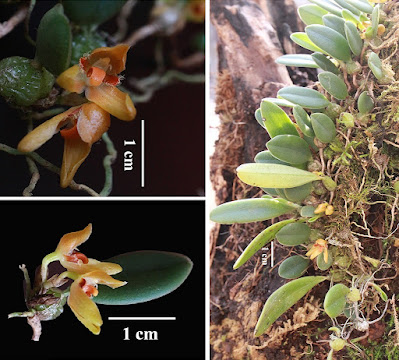 |
| Bulbophyllum pilopetalum M. K. Li, J. P. Deng & Y. Luo, in Li, Tang, Deng, Tang, Shao, Xing & Luo, 2023. DOI: 10.7717/peerj.14721 |
Abstract
Background: Chloroplast (cp) genomes are useful and informative molecular markers used for species determination and phylogenetic analysis. Bulbophyllum is one of the most taxonomically complex taxa in Orchidaceae. However, the genome characteristics of Bulbophyllum are poorly understood.
Methods: Based on comparative morphological and genomic analysis, a new species Bulbophyllum pilopetalum from eastern Himalaya belonging to section Cirrhopetalum is described and illustrated. This study used chloroplast genomic sequences and ribosomal DNA (nrDNA) analysis to distinguish the new Bulbophyllum species and determine its phylogenetic position. An additional phylogenetic analysis was conducted using 74 coding sequences from 15 complete chloroplast genomes from the genus Bulbophyllum, as well as nrDNA sequences and two chloroplast DNA sequences from 33 Bulbophyllun species.
Results: The new species is morphologically similar to B. pingnanense, B. albociliatum, and B. brevipedunculatum in vegetative and floral morphology, but it can be distinguished by its ovate-triangle dorsal sepal without a marginal ciliate. The chloroplast genome of the new Bulbophyllum species is 151,148 bp in length, and includes a pair of inverted repeats (IRs) of 25,833 bp, a large single-copy region (LSC) of 86,138 bp, and a small single-copy region (SSC) of 13,300 bp. The chloroplast genome includes 108 unique genes encoding 75 proteins, 30 tRNAs, and four rRNAs. Compared with the cp genomes of its two most closely-related species, B. pingnanense and B. albociliatum, this chloroplast genome exhibited great interspecific divergence and contained several Indels that were specific to the new species. The plastid tree showed that B. pilopetalum is most closely-related to B. pingnanense. The phylogenetic tree based on combined nrDNA and chloroplast DNA sequences indicated that section Cirrhopetalum was monophyletic and B. pilopetalum was a member of this section.
Discussion: The taxonomic status of the new species is strongly supported by cp genome data. Our study highlights the importance of using the complete cp genome to identify species, elucidate the taxonomy, and reconstruct the phylogeny of plant groups with complicated taxonomic problems.
Bulbophyllum pilopetalum M. K. Li, J. P. Deng & Y. Luo sp. nov.
Diagnosis. Similar to B. brevipedunculatum, B. albociliatum, and B. pinganense, but differs by having a shorter peduncle, triangle dorsal sepal with margin entire, oblong petals, and divergent lateral sepals twisted slightly near the apex.
Etymology. The specific epithet “pilopetalum” refers to the petal margins dense with white ciliate.
Mengkai Li, Lu Tang, Jianping Deng, Hanqing Tang, Shicheng Shao, Zhen Xing and Yan Luo. 2023. Comparative Chloroplast Genomics of Three Species of Bulbophyllum section Cirrhopetalum (Orchidaceae), with An Emphasis on the Description of A New Species from Eastern Himalaya. PeerJ. 11:e14721. DOI: 10.7717/peerj.14721


